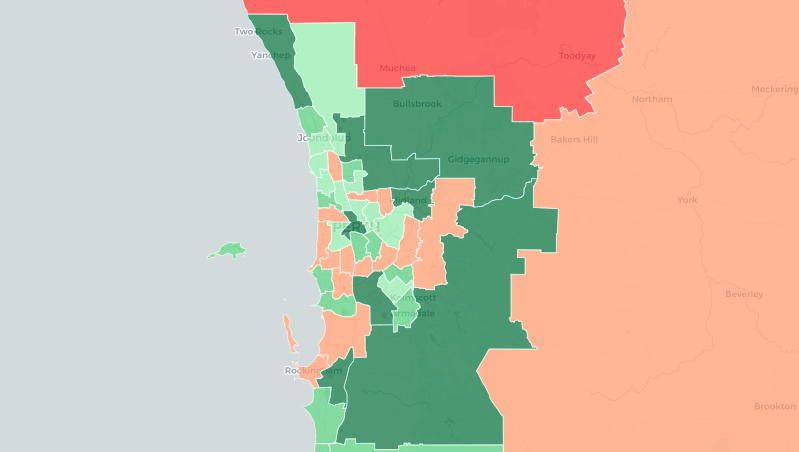While we’re all focused on the federal election and the recent NSW state election, a number of redistributions have been kicked off for Western Australian state elections and the territory Legislative Assemblies in the Australian Capital Territory and the Northern Territory. I’ve already analysed the likely outcomes for the ACT redistribution, and I’ll be back later this week with an analysis of the NT redistribution.
I’m just going to quickly run through the process, timeline and what the current population numbers tell us about likely changes.
Western Australia redraws its electoral boundaries after every election. Electorates must fall within 10% of the average population as of the redistribution. There is an exception for for districts covering an area of more than 100,000 square kilometres. In these Large Districts, a number of ‘notional’ electors can be added to the actual electors when calculating the quota – this number is arrived at by multiplying the square kilometres by 1.5%. This means there are six seats which (at least on current boundaries) are not required to have as large a population.
The following map shows how much each seat currently diverges from the quota, based on this election data. Seats over quota are coloured green, while those under are coloured red. Those which diverge by more than 10% are in a brighter colour.
You can see that, in the Perth area, outer suburban seats are all over quota, a number of them well over quota. There are some Perth seats in the mid-range suburbs which are under-quota, but none of them are massively under quota.
On the other hand, a majority of the large rural seats are far under quota, while a handful are slightly over quota.
The regional picture can be seen more clearly in this table:
| Region | Seats | Variation from quota |
| Agricultural | 4 | -20.9% |
| East Metro | 14 | 70.1% |
| Mining and Pastoral | 4 | -38.4% |
| North Metro | 14 | 54.3% |
| South Metro | 15 | 24.8% |
| South West | 8 | 41.1% |
There are six upper house regions in Western Australia. Each elects the same number of members of the upper house, despite dramatic differences between populations in the urban regions and the large rural regions. Yet (apart from the Large District Allowance) lower house seats are expected to have roughly the same population.
Between the three metro regions and the south-west, there is about 1.9 quotas worth of voters more than the 51 seats in these areas. This suggests that at least one extra urban seat will need to be created, and possibly a second.
The East Metro and North Metro regions are particularly over-quota, so it seems likely one of these regions will gain a fifteenth seat, with knock-on effects resulting in a seat in the Agricultural or Mining and Pastoral regions being abolished.
Yet, despite the continued decline in population in these two regions, there will be no change in the balance of power in the upper house. These two regions cover just over 10% of the state’s electors, yet they continue to elect one third of the state’s MLCs. And that won’t be changing in this process.
The timetable for this redistribution process is here. Suggestions for changes to electoral boundaries opened last Saturday, with the deadline for submissions being April 29. Comments can then be lodged over the next two weeks. The proposed boundaries will be published in late July, with the final boundaries confirmed in November. I’ll be laying low in July but I’ll be sure to come back soon after with a new map and analysis of the boundary changes.




Awful malapportionment in the WA upper house, but if you try to represent the electorates fairly it will look like a few Perth electorates, a south-west electorate and “rest of WA”. I think it would be a good candidate for an “at large” system like SA or NSW.
To make it less ridiculous, reduce the size of the upper house (22?) and move all those slots to the lower house. WA electorates are already tiny but I don’t see the issue with that (in fact there’s something lovely about the NT system where MPs can realistically get to know their entire electorate), and it would allow more towns to have their own electorates.
Comments are closed.